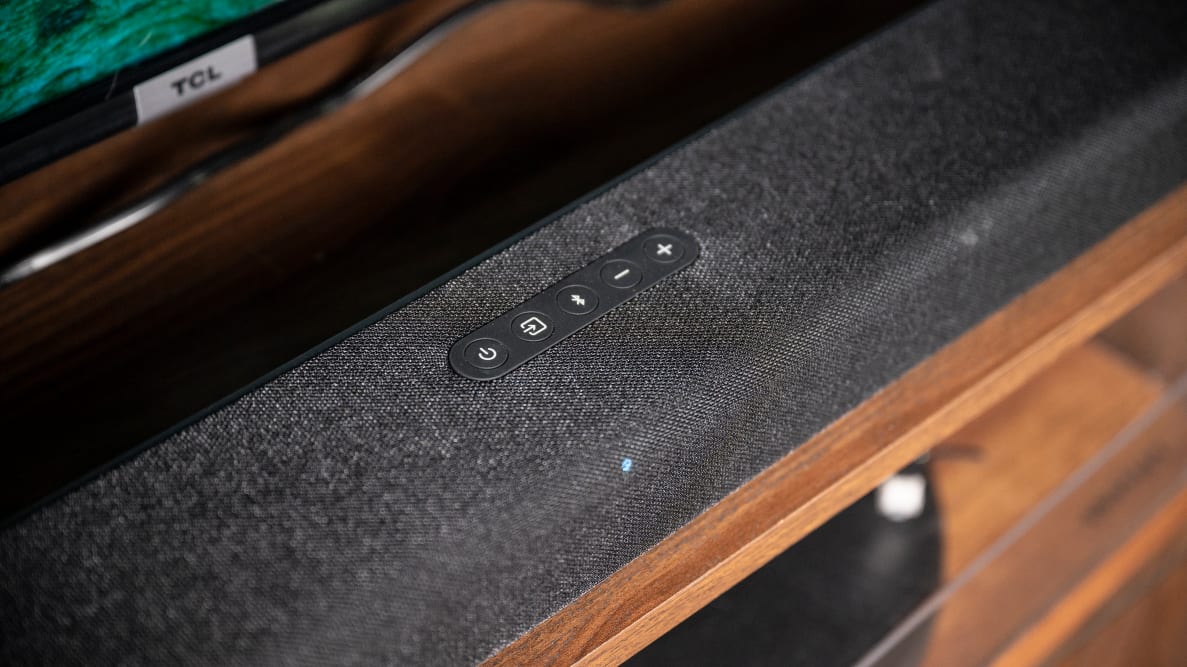Pros
-
Great sound signature
-
Real, affordable Dolby Atmos
-
Simple setup and use
Cons
-
Limited settings
-
No Wi-Fi
About the Polk Audio Signa S4
- Height x Width x Depth: 2.4 inches x 3.7 inches x 41.2inches (bar), 11 inches x 7.9 inches x 12.9 inches (subwoofer)
- Weight: 8.8 pounds (bar), 13.2 pounds (subwoofer)
- Speakers/drivers: two 1-inch tweeters, two 1.6-inch midrange drivers, one 1-inch full range center driver, two 2.6-inch elevation drivers (bar), one 5.9-inch woofer (subwoofer)
- Amplification: 410 watts of claimed power
- Wireless connection: Bluetooth
- Wired connection: One HDMI eARC/ARC, digital optical, 3.5mm analog
- Sound formats: Dolby Atmos, Dolby Digital Plus, Dolby TrueHD
- Video support: 4K HDR, Dolby Vision passthrough
Alongside the soundbar itself and its accompanying wireless subwoofer, the Signa S4’s packaging contains standard accessories like an HDMI cable, optical cable, wall mount template and spacers, quick start guide, and a pair of AAA batteries to complement the bar’s remote control. In short, it’s got everything you need to unbox and get started.
There isn’t much to write home about in the looks department of the Signa S4. Frankly, it resembles your run-of-the-mill soundbar, with a subwoofer that looks more akin to a toaster on first glance. That said, its height of only 2.4 inches and similarly slim depth makes it quite simple to add to most setups.
What we like
Streamlined setup and usability
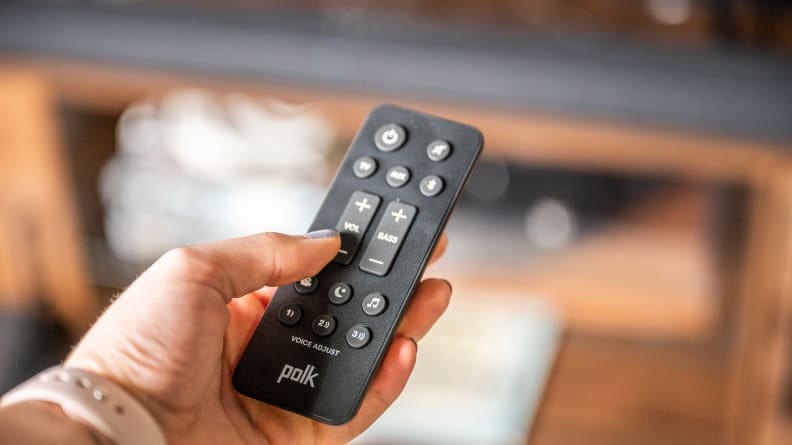
There's not much to the setup, which lets novice users skip the headaches and get going right away.
Polk designed the Signa S4 to be a quintessential “plug-and-play” product, and in that regard, it easily meets expectations. An HDMI connection (preferably, though digital optical or analog will suffice if you don’t need Dolby Atmos) and power for both the soundbar and subwoofer are all you really need to begin your experience. From unboxing to watching, the entire setup process was over in less than 10 minutes.
From there, you can use your TV remote to control power and volume. Polk’s compact remote control offers further controls—it’s a simplistic solution that leaves out some crucial settings (more on that below), but the options it does offer couldn’t be more straightforward. Between a dedicated button for adjusting bass levels, three different sound modes (Movie Mode, Night Mode, Music Mode), and three different voice adjust buttons, Polk did an excellent job of making it incredibly easy to make quick, general adjustments to your sound.
Darn good sound overall
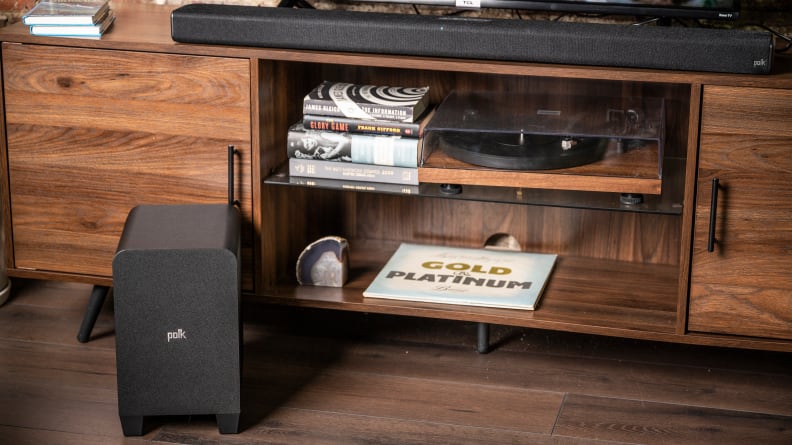
Polk's signature balanced and clear sound makes this bar great for all kinds of listening.
The biggest highlight of the Signa S4 is its sound performance, which should come as no surprise from a brand that’s been in the business for more than five decades. Polk’s avenue to competing in the endlessly expanding world of soundbars is audio quality, and it leaned in hard with the latest addition to its lineup.
A screening of The Adam Project was a fun treat for the ears, on multiple fronts. The soundbar presented a nice, wide soundstage for the movie’s opening space-chase scene, all the while delivering quippy dialogue from Ryan Reynolds without skipping a punch line.
The included wireless subwoofer isn’t a foundation-shaking juggernaut, but it did fill out the low end admirably across multiple action sequences. And, the soundbar nailed the film’s surprisingly kick-ass soundtrack, effortlessly belting out standouts like Led Zeppelin’s “Good Times, Bad Times,” and Boston’s “Foreplay/Longtime” with exceptional detail and precision.
There isn’t a dramatic difference between the soundbar’s Movie Mode and Music Mode, but there is enough of a distinction to determine that each mode sounds better for their respective types of content. When it comes to sound settings, the voice adjust buttons are the stars of the show. With something like Hulu’s Pam and Tommy biopic, where the dialogue often fluctuates between Lily James’ soft-spoken portrayal of Pamela Anderson and Sebastian Stan’s at-times irate Tommy Lee, being able to toggle between different voice volumes without adjusting the bar’s overall levels was a nice perk.
Affordable Dolby Atmos that’s the real deal

At this price, we were impressed by the S4's immersive Dolby Atmos presentation.
With a pair of built-in upfiring drivers, the Signa S4 is one of the most affordable, true Dolby Atmos soundbars we’ve tested. For comparison’s sake, Monoprice and Vizio make more complete, 5.1.2 packages for around $100 more (including dedicated surround sound speakers), and the Sonos Beam (Gen 2) has virtual Dolby Atmos (and several other features) for about a $50 upcharge. For the real thing, however, the cheapest ticket around might just be the Signa S4.
It’s good Dolby Atmos, too. My go-to Atmos scenes from blockbusters like Blade Runner 2049 and Dune had a stellar three-dimensional presence, depicting heavy downpours of rain and an unrelenting sandstorm remarkably well, respectively. It’s dependent on the acoustics and dimensions of the space you’re in, of course, but I was impressed with what I heard, especially at this price.
To be clear, the Signa S4 certainly isn’t on the level of a behemoth like the Samsung HW-Q950A, our current favorite Atmos soundbar. And while Polk says standard audio can be up-mixed for virtualized Atmos, watching true Atmos content was a noticeably better experience. Still, it’s hard to find too many faults with what this Atmos bar is capable of for a cool $400.
What we don’t like
One sound (unfortunately) fits all
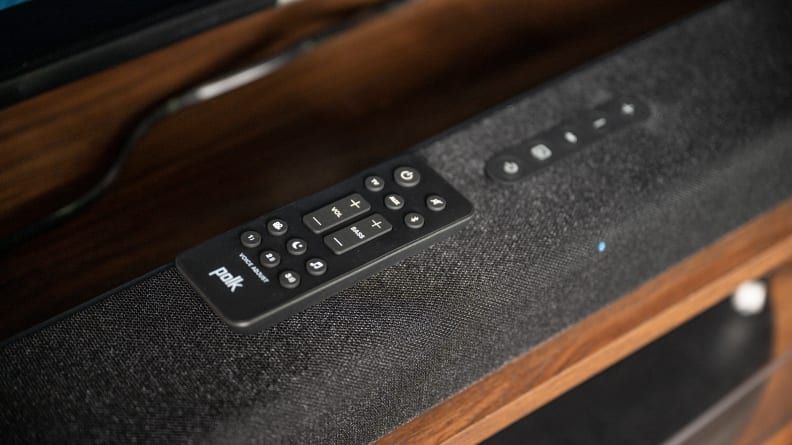
Without a dedicated app or on-screen interface, sound adjustment is very limited.
Outside of bass adjustments, three different sound modes, and the preset voice adjustment buttons, there are no other ways to adjust the EQ of the Signa S4. You can’t touch the treble, you can’t dampen or enhance individual channels or drivers, and you can’t boost the soundbar’s upfiring speakers in an effort to correct for potentially high ceilings.
Granted, part of the allure of the Signa S4 is the quality that it comes equipped with straight out of the box. Many folks simply won’t need the ability to fine-tune a soundbar that sounds this good. That’s no excuse, however, for not giving the enthusiasts who did want the option to dial in their sound settings a legitimate path to doing so.
Limited streaming solutions
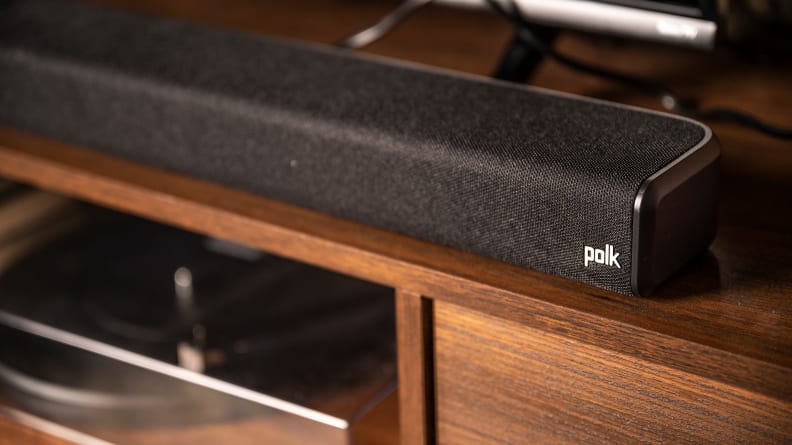
The bar's lack of Wi-Fi makes Bluetooth your only streaming option.
Your options for streaming music directly to the Signa S4 from your mobile device are Bluetooth and … Bluetooth. There’s no Wi-Fi support, which takes higher-quality options like Chromecast and Spotify Connect off the table for Android users, while iOS users will have to go without AirPlay support as well.
The necessary caveats here are that Bluetooth is a perfectly fine way to stream music in today’s modern world. And, assuming the Signa S4 is connected to a modern TV, chances are you’ll be able to stream to the bar through your TV as a potential workaround. Still, especially considering the fact that this bar’s predecessor (the Signa S3) had built-in Wi-Fi and Chromecast, it’s an unfortunate omission in this newer product.
Should you buy it?
Yes, if sound matters more than features
The Polk Audio Signa S4 makes the most sense for anyone searching for a fantastic set-it-and-leave-it solution. The system is strikingly simple to set up and get going, and it’s carved out a few easy adjustments to aid important sound settings like bass and dialogue. On top of that, it’s a great-sounding package regardless of the content you send its way, and offers relatively impressive Dolby Atmos immersion at a very reasonable price point.
If you’re after more than a no-frills soundbar experience, however, you may want to look into something like the Sonos Beam (Gen 2). On top of being a good soundbar with some solid virtual Dolby Atmos, it offers high-quality streaming and a widely expandable ecosystem of Sonos products that can be connected over Wi-Fi to expand its soundstage or turn it into a whole-home sound solution. If you want a slightly more cinematic experience, the Vizio M-Series 5.1.2 soundbar adds rear speakers for not much more, though it too leaves out extras like Wi-Fi streaming or multi-room audio support.
All that said, if you can live without Wi-Fi and adjustments for EQ and speaker levels, the Signa S4 drives a hard bargain for anyone who wants to instantly add great sound quality and impressive Dolby Atmos to their TV room.
Meet the tester
Nick Woodard is a tech journalist specializing in all things related to home theater and A/V. His background includes a solid foundation as a sports writer for multiple daily newspapers, and he enjoys hiking and mountain biking in his spare time.
Checking our work.
Our team is here to help you buy the best stuff and love what you own. Our writers, editors, and experts obsess over the products we cover to make sure you're confident and satisfied. Have a different opinion about something we recommend? Email us and we'll compare notes.
Shoot us an email